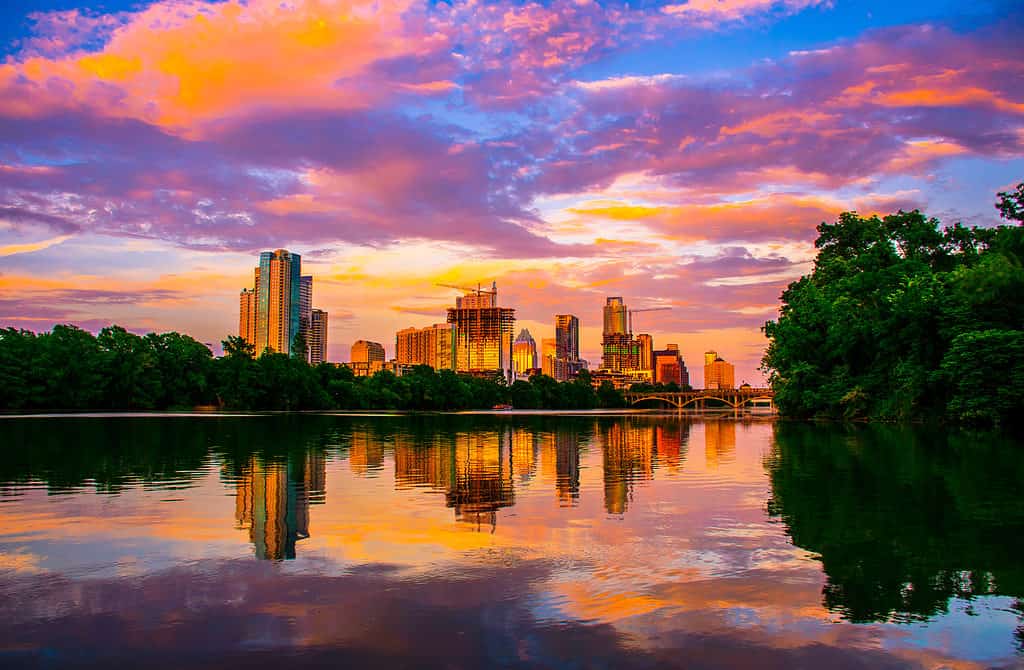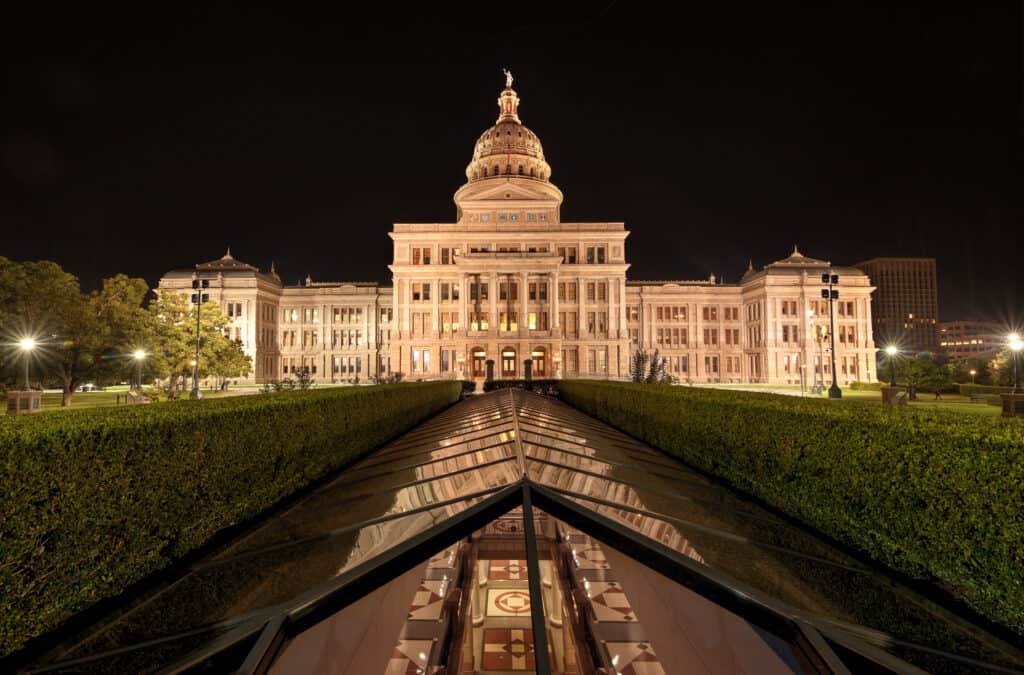These days, Austin, TX is known for being a quirky city that is referred to as “the place young people go to retire.” Mottos of the city include “Keep Austin Weird,” which is a nod to Portland, Oregon‘s famous “Keep Portland Weird” sign. Other mottos include “The Live Music Capital of the World,” “Silicon Hills,” and “City of the Violet Crown.” With everything happening in the hip city, people shouldn’t forget that it is also the state capital of Texas.
Why Is Austin the Texas State Capital?
Before Austin was the capital, there were a few other cities that had the honor first. However, in 1839, Austin was established as the capital. The first capital building there was a log cabin with two meeting rooms and a few smaller rooms. It was mainly chosen for two reasons.
First, it was in the western portion of the state. Legislators wanted to establish a stronger foothold in this area at the time. Moving the state capital there from Houston, which served as the state capital from 1837-1839, would help them do that.
Second, Austin was just beginning as a city at the time. It had plenty of space to plan the layout around a new capital and create an ideal design.
Other cities that served as the Texas state capital include:
- Washington-on-the-Brazos
- Harrisburg
- Velasco
- Columbia
- Houston

Austin became the capital of Texas in 1839.
©Roschetzky Photography/Shutterstock.com
When & Why Was Washington-on-the-Brazos the Capital of Texas?
Washington-on-the-Brazos was only the Texas state capital for about two weeks, from March 1 to March 17, 1836. It is known as “The Birthplace of Texas” because that is where politicians met to come up with a state constitution and where Texas’ Declaration of Independence from Mexico was signed. This was a key moment in the Texas Revolution, the war that ultimately separated Texas from Mexico and allowed it to become part of the United States.
At this gathering, politicians wanted the state capital to remain in Washington-on-the-Brazos. However, most people preferred Austin, which was called Waterloo at the time. Even so, it would be a few years before Austin would become the official state capital.
Today Washtingon-on-the-Brazos is a small unincorporated community of just more than 250 people. The town has a few historical sites and museums dedicated to the historic events that happened there in 1836.
When & Why Was Harrisburg the Texas State Capital?
After declaring their independence from Mexico in Washington-on-the-Brazos, Texas delegates worried that Mexican troops would retaliate. So, they retreated to Harrisburg, making that a temporary state capital. However, that was also short-lived. On April 16, 1836, Mexican troops reached Harrisburg and burned nearly all of the city to the ground. The President of Texas at the time, David Burnet, and others survived by waiting out the battle on a boat, then moved on to a new location.
Now, Harrisburg is a community within the city of Houston, Texas. There are about 2,000 people who live in this neighborhood.
When & Why Was Velasco the Capital of Texas?
After Harrisburg, Texas delegates moved on to Velasco. There, they had a bit more luck and Velasco remained the capital for a few months, until September of 1836. On May 14 of that year, the general of the Mexican Army, Antonio Lopez de Santa Anna, signed the Treaties of Velasco here, which acknowledged Texas’ independence from Mexico.
The community of Velasco is now part of Freeport. There isn’t information about the population of the community, because it is not counted separately in census information. The most recent population counted specifically for Velasco was in 1956. At that time, the population was around 4,000. It is now part of the Brazosport industrial area in the city of Freeport.
When & Why Was Columbia the Texas State Capital?
Columbia, now known as West Columbia, was the Texas state capital from September to December of 1836. It was here that the First Congress of the Republic of Texas took place, where Sam Houston was elected president. While Columbia was the capital, many legislative activities happened in private residences and there wasn’t enough living space for all the legislators. So, in December of 1836, lawmakers voted to find a new capital and chose Houston.
Today, West Columbia is a small town of around 3,500 people. Many people who live in West Columbia commute to nearby Houston or other nearby towns and cities where there is plenty of work in the oil or gas industries.
When & Why Was Houston the Texas State Capital?
Sam Houston became the first president of the Texas Republic in 1836. Shortly after, in 1837, he moved the capital to the city that bore his namesake. However, the city wasn’t founded by Sam Houston. It was started by the Allen brothers in 1836, who then advertised the new city in the newspaper to try to get people to move there. They were the ones who lobbied legislators to move the capital to their new city. By the time it became the state capital, there were only about 12 people living there. But, shortly after being chosen as the capital, the population grew quickly to about 1500 people. Houston only remained the capital until 1839 when it was moved to Austin.
In 1872 the people of the state of Texas voted on whether to keep the capital in Austin or move it to Houston. They chose Austin, cementing the city as the state capital where it remains to this day.
Today, Houston has come a long way from the first 12 people to settle there. It is now the 4th largest city in the United States. Only New York, Chicago, and Los Angeles are larger. Over 2 million people live in Houston, which takes up over 600 square miles. It is a vibrant city with a lot to offer including live sporting events with professional teams, concerts, art performances, the longest-running rodeo, and an amazing restaurant scene.
What Is Austin Like Today?

Austin is the sixth city chosen as the Texas state capital, following a long line of other cities that left their mark as locations for the capital in the 1800s.
©iStock.com/ToddAaron
Today, Austin is the 11th largest city in the United States, population-wise with 964,177 people living there. The city is known for quirky events such as a pun competition, an annual birthday party for the beloved AA Milne character, Eeyore, and a food festival that celebrates the food product SPAM.
In addition to live music of all kinds and a vibrant nightlife scene, it is still the place where laws are made for the state of Texas. There is also a strong brewery scene, lots of unique food trucks, and a plethora of restaurants that serve a variety of cuisines, including barbecue.
.
The photo featured at the top of this post is © iStock.com/RoschetzkyIstockPhoto
Thank you for reading! Have some feedback for us? Contact the AZ Animals editorial team.






